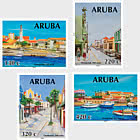Release years
2017125 Years Post Aruba - Set
2017 125 Years Post Aruba - Set for only GBP £3.29

- 31.07.2017
- Frank Croes
- -
- Joh Enschedé Security Printers
- -
- -
- -
- 90c, 130c, 320c, 390c
On August 1, 1892 an ordinance regulating the Postal Service in Aruba within the "Colony Curaçao" became effective. On this date it started with an improvement of the post-administration in a branch of the Post Office in order to secure the delivery of letters. The ordinance was signed by Governor Mr. Charles A. H. Barge, while Mr. Jacob Thielen, as authority in Aruba, was in charge with the Postal Service.
The activities took place in the house of Mr. Thielen that was built around 1830 and demolished in 1949. This building was situated where the Plasa Daniel Leo is located right now in the Kazernestraat, Oranjestad.
90c: Garibaldi Cephas Helder, better known as "Ba", was born on September 25, 1861 and died on April 9, 1939. Mr Garibaldi was already employed at the beginning of the operation of the Post Office and he was responsible for the collection and delivery of the post-items from and to the port. He used to ring the bell so that everyone knows that they can go to the post office to pick up their post.
130c: The Post Office in San Nicolas. This office was officially opened on August 16, 1936. The stamp represents the old structure of the Post Office in San Nicolas, which has been given a different facade after renovation.
320c: A postman delivering post at a residence. On this stamp we can appreciate the uniform used by the postmen dated back since March 1, 1957.
390c: The current main Post Office of Post Aruba N.V. located at J.E. Irausquinplein # 9, Oranjestad which was inaugurated on May 2, 1964.
Post Aruba moved to this office in 1958 and is still located here. The building was designed by A.A. van Ammers. The structure reflects the design elements of earlier decades, namely 1930-1950.
Aruba - Recommended stamp issues
WOPA+ recommended stamp issues
| Avatar - Fire and Ash |
| Issued: 03.12.2025 |
| ›New Zealand |
| 50th Anniversary of the Founding of the 24th November Bar Scout |
| Issued: 24.11.2025 |
| ›Montenegro |
| Krisjanis Valdemars |
| Issued: 02.12.2025 |
| ›Latvia |
| Sign Language - Good |
| Issued: 02.12.2025 |
| ›Bosnia and Herzegovina - Republic of Srpska |
| In Memory of the Fallen and Murdered on October 7, 2023 |
| Issued: 08.10.2025 |
| ›Israel |
| Annual Collection Folder (New York) |
| Issued: 05.12.2025 |
| ›United Nations |
| Year Set |
| Issued: 24.11.2025 |
| ›Isle of Man |
| Shipping in the 17th and 18th Centuries - Peat Shipping |
| Issued: 05.12.2025 |
| ›Netherlands |




































